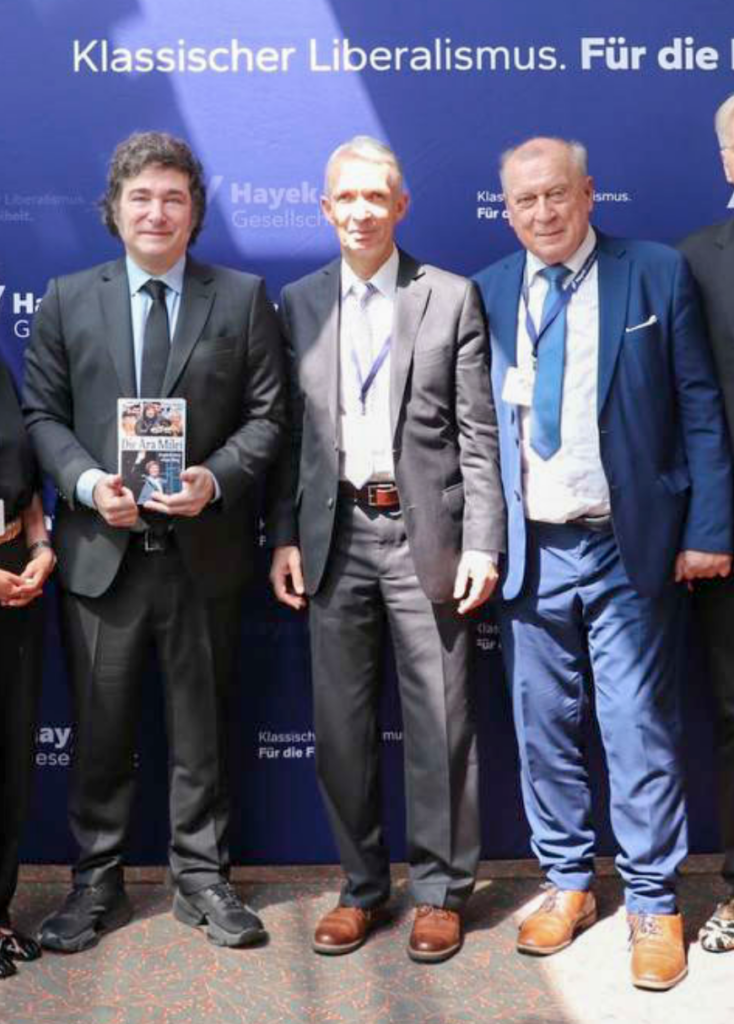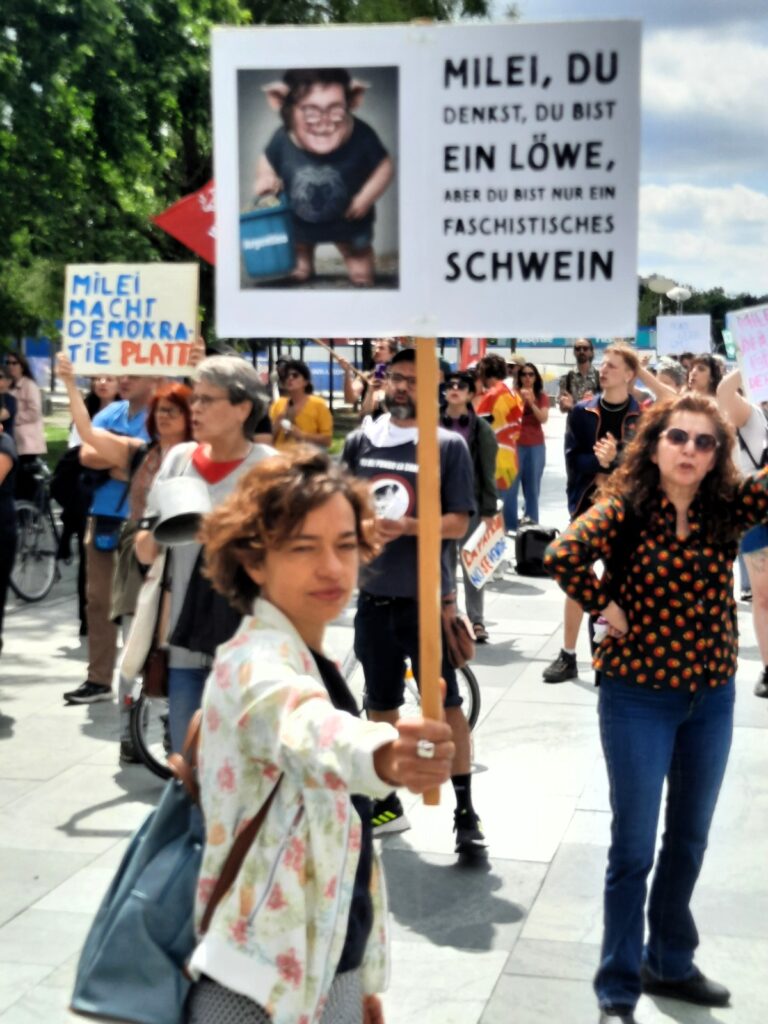
This latest visit of the flamboyant Argentine president Javier Milei to Europe has been a curious one. It began in Spain, where a state visit was not on the cards due to Milei’s shenanigans on a recent trip hosted by the Spanish far-right Vox party. Milei’s “hatred of Socialism” drove him to extremely undiplomatic language when describing Pedro Sanchez, Spain’s prime minister. “He has a corrupt wife, he gets dirty, and takes five days to think about what to do”, Milei said. The incident was described by José Manuel Albares, Spain’s foreign minister, as “a frontal attack on our democracy, on our institutions and on Spain”.
Instead, in Spain, Milei was received by an obscure Libertarian think-tank called the Instituto Juan de Mariana (Mariana was a priest from the 1600’s) where Milei received an ‘award’, the first of three. The Spanish government has recalled its ambassador from Buenos Aires. With two more awards to collect Milei moved on to Germany then to the Czech Republic.

Javier Milei refused Germany’s offer of a planned official visit, cancelling this instead for a “work meeting” in Berlin. Before visiting the capital Milei’s entourage traveled to Northern Germany where he received a medal from a fringe right-wing economics institute called the Friedrich A. von Hayek Society. On that stage in Hamburg was the executive director Gerd Habermann. whose exuberance overflowed in an article in achgut.com where Gerd described Milei’s radical reform agenda as “nothing less than the abolition of the egalitarian welfare state“. Just in case people missed the point he confirmed “not just it’s reform“.

Milei also added an hour-long meeting with Germany’s prime minister Olaf Scholz, on the condition they respected Milei’s “clear refusal” to hold a news conference. Milei the proclaimed abolitionist of the welfare state, speaking with chancellor Scholz (a social democrat) might have raise some eyebrows but sources suggested that Milei spoke about new Lithium mines while Scholz suggested slightly less apocalyptic social policies in Argentina. As there was no press conference we may never know what they spoke of. Outside in Streets of Berlin Milei was received by protestors with placards reading “Milei, you see yourself as a lion but you’re just a fascist swine!”. He saluted the protestors in a mocking manner from behind a barrier and got back into his vehicle.
Onward to Prague where Milei again received another award from an obscure local liberal think-tank called the Liberalni Institut. Some reports suggest this award was unofficial and later revoked. Liberalni is another euro-skeptic institution which actively cooperates with the German right-wing Friedrich-Naumann Foundation. Milei’s third award was for “Contribution to the proliferation of liberal thinking, and making ideas of liberty, private property, the rule of law, come true“. He posted the Liberalni certificate on his Instagram page .
But is Milei really traveling to Europe just for awards, or is he, as his spokesman reported to Forbes, looking for a model solution for the Argentine economic woes in, of all places, Ireland?
Argentina is not Ireland, here’s why
“Being like Ireland is a higher goal for Argentina than being like Germany: that is always Javier Milei’s idea.” So began Milei’s spokesperson Manual Adorni’s, in a pre-European tour interview with Forbes Argentina where he outlined Milei’s European tour and his long-term economic model. Digging a little deeper we see that Ireland itself isn’t Milei’s goal but Ireland’s GDP-by-population ratio is.
Milei’s best-case scenario for Argentine economic development, indeed his model for Argentine development is Ireland’s GDP-by-population ratio. So, as an Irish economist living in Argentina, I decided to investigate some of the paradoxes at the core of Milei’s Irish economic plans for Argentina. The unquestioned assumptions in Milei’s vision are, to put it mildly, rather concerning.
A Quick Analysis of Milei’s Irish vision for Argentina
Step 1: What are Milei’s stated goals for Argentina? Milei’s economic manifesto is based on “returning” Argentina to it’s status as a global power. Trump likes to call this Make Argentina Great Again. Rewind a moment… Returning Argentina to what? At no point in history has Argentina ever been a global power. To be honest, at least while Javier Milei is still in power, maybe that is a good thing!
On a technical level Milei (when he’s not giving speeches anyway) isn’t talking about Argentina’s political power 100 years ago but just its economy and even then he is relying on just one statistic viewed and from his curious fringe economic cult of Libertarianism. Milei measures Argentina’s historic ‘power’ in the Argentine golden ‘Liberal’ economic era, 1880-1920, by the ratio of GDP to population.
Milei’s economic revisionism requires reconstructing GDP (a measure which did not exist 100 years ago) and dividing by the historic Argentine population to calculate the GDP-per-person. Ireland’s GDP per person is extremely high, argues Milei, Argentina’s was then, and Argentina’s can be high again. So Ireland is the model.
So far so good. But let’s take a look at the numbers.
Even assuming one can retroactively reconstruct 100 year old Argentine GDP numbers, there still remains the question of population (or rather economically active population) a small number in Argentina 100 years ago, but probably also severely under-counted. If you divide by a small number (an under-counted population) you get an artificially big ratio so this is relevant.
At the turn of the 20th century the Argentine indigenous people were basically not even recognized as human so their census numbers are immediately suspect. Even white immigrant Argentine women, whether they worked in the home, the farm or the factory (indeed even white women land-owners) did not get the vote till the 1950’s. Also much of Argentina’s agricultural workforce at the time was migratory, traveling by ship from Galicia in Spain, and overland by train from neighboring countries, so the census did not accurately reflect the workforce population. It underestimated it.
Comparing Argentina 100 years back with Ireland in the 21st Century presents even more challenges. But let’s go with the analogy a bit more to see why. In doing this I’ll assume and the relevance of both Argentine GDP and the population numbers in 1900. Still, though, Milei’s GDP-by-population comparison with modern Ireland is still quite perverse on so many levels.
To see why requires taking a short deep dive into Irish GDP. Irish recent population statistics are sufficiently close to reality to use but Ireland’s GDP is wildly inflated, also the economies are vastly different.
Milei is comparing apples with oranges.
Apples & Oranges
Let’s stretch the model yet again. We’ll assume valid retroactively calculated GDP divided by a dodgy 100 year old population statistics and accept they still provide some notion of economic power, which, in a very limited economic sense, they do However one has to question whether the two economies are really comparable. National economies produce different products and services, they use different technologies, they have different markets and they also have different taxation regimes and trade agreements.
Concretely Ireland is a member of the European Union and Argentina is a member of Mercosur. One free trade area works, the other not-so-much. A valid economic comparison is one which compares like with like, or one that at least one take differences into account. Milei fails to do either.

Argentina in its heyday was a largely rural economy. It’s global economic rôle was exporting food (particularly grains and meat) largely to Europe, especially during WWI. Ireland too exports food but agriculture plays a tiny rôle in Ireland’s 2024 economic activity when measured in GDP terms. Most importantly Ireland’s GDP is not real, it’s extraordinarily inflated. Ireland’s external accounts (especially exports) are so fictional that they’re often described as Leprechaunomics. If you divide a huge number (an inflated GDP) by a small population (about five million in Ireland) you get a huge ratio of GDP-to-population but this ratio means nothing so it is a distorted model by definition.
Leprechaunomics is a derogatory phrase, used mainly in the US. It describes the reality of Irish GNP when compared with GDP stats. Leprechauns don’t exist and neither do many of Ireland’s exports, but they are counted in Ireland’s GDP. Ireland’s export statistics are distorted by economic activities, which really occur in other countries (primarily, but not exclusively, other countries in the EU). This economic activity is shifted to Ireland for tax reasons by multinationals, a procedure called transfer pricing.
Perhaps a brief explanation might clarify?
Transfer pricing allows multinational corporations to move real economic activity around their national affiliate companies to avoid tax, this involves price distortion, re-categorising of economic activity to avoid taxation and moving transactions off the books of one local multinational branch onto the books of another (in Ireland for example). Multinationals do this to take advantages of taxation loopholes (mismatches) between nations. The maximum tax rate on corporate profits in Ireland is 12.5% (less than half that of Argentina) but multinationals usually pay less than 1% so they do a lot of transfer pricing (hundreds of millions or billions of euros per year, for some large corporations) to Ireland. US Multinationals with large EU customer bases transfer profits to Ireland to be taxed there, then shift the money on to offshore tax havens in the Caribbean like the British Virgin Islands (BVI).
The effect is that multinationals with very few real transactions in Ireland’s small economy, appear to have billions of dollars of transactions in Ireland (which really happen elsewhere). End effect: Ireland’s GDP is inflated. Milei can’t do that in Argentina so the comparison makes no sense.
Let’s go deeper. Most of what Ireland exports are in three sectors: financial services, pharmaceuticals and software and computational services. The latter includes Google, Microsoft, Meta, Twitter/X, LinkdIn and Apple (all with EU bases in Ireland). Milei visited many of these in the US recently. These multinational corporations all export vast virtual “exports” through Ireland which really happen in the rest of the world. Remember transfer pricing distorts GDP.
An example might come from Google’s German advertising sales. These are price shifted and mis-categorised as earnings on “intellectual property” from Germany to Ireland to maximise tax loopholes. This offshoring of Google’s German advertising profits inflates Irish GDP. Leprechaunomics!
Milei can’t apply this logic to Argentina’s exports of grains, meat, lithium or gold. Milei’s visions can’t compete with Google transfer pricing in Ireland.
Last but not least the choice of Ireland as an export location by global multinational capital has much to do with other factors not directly related to tax rates. For example Ireland is an advanced educated English-speaking workforce located in the richest global block of nations in the World (the EU) with some of the best educated humans on the planet whose online activities providing essential input feeds for AI. Argentina, not so much. The European Union is also relevant. Argentina isn’t in Europe.
So very little of Ireland’s GDP is comparable to Argentine GDP, now or 100 years ago. Even if some could be, Milei’s disinvestment in research and education makes it even less likely that it will in the future.
Much of Ireland’s success came from its association into trading blocks that work like the European Union. Milei, in his contrarian manner, is consistently against the development of Latin American trading blocks like UNASUR, Mercosur and BRICS+. If Milei liked economic blocks then Argentina could theoretically benefit like Ireland did but Milei, instead, has vetoed regional blocks like BRICS+ membership for Argentina. He wants Argentina to go it alone with the USA and Israel, it’s absurd.
Milei may be trying to change the national Argentine currency to the US dollar (which is a bad idea anyway) but even that would be a far cry from changing Argentina’s language to English, developing a stable South American EURO, or investing in quality education and research at the levels existing in Germany, Spain, Ireland or the US. Milei’s delusions are deep.
In short the comparison of Argentina and Ireland does not apply. Ireland is a bad model to use. Maybe try Brazil whose GDP is growing and not collapsing 5% like Milei’s Argentina. To use a quaint Argentine aphorism, Milei’s economic vision of Argentina as a modern Ireland is a “nube de pedos”[1].
[1] Chimera might be a polite translation.

Excellent analysis! I ll translate it to German, should be read there, too.